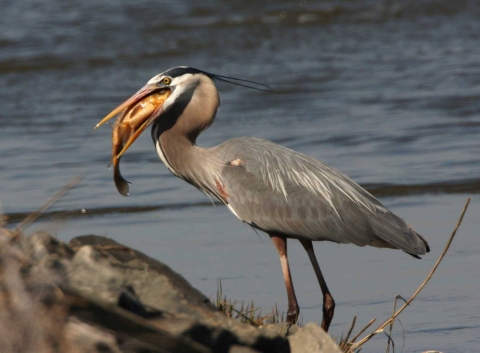Develop a plan
If you are experiencing a problem with heron and/or egret breeding colonies, we strongly encourage starting your harassment program as soon as the first birds appear. Hazing birds aggressively and continuously immediately upon arrival will help ensure that birds do not become accustomed to a site. They may begin to arrive in early March, so it important to be prepared and have a plan in place ahead of time. Herons and egrets can be harassed and excluded without a permit any time except during their breeding season when eggs and/or young are present; typically April – August.
Methods
Using a suite of harassment techniques is more effective at deterring birds than using a single method. Hazing equipment, especially noise-making devices, are usually more effective when moved frequently (e.g. daily) to prevent birds from becoming accustomed to the devise. Birds will eventually learn to ignore any hazing device that is left in the same place or that emits sounds in the same pattern over extended periods of time. Hazing devices will not be effective unless used aggressively and frequently changed. Adequately equipped bird dispersal patrol teams can be used to harass and frighten birds in the immediate area. Here are some techniques you may wish to consider:
Landscaping to deter nesting colonies
Herons and egrets need trees of substantial size to support their nests. Pruning and/or removing trees during the non-breeding season to eliminate perches and nest sites can reduce the amount of habitat available to waterbird colonies. If the birds return the following year, continue to prune perches and nest sites before the first egg is laid. All deterrent measures must stop once the first egg is laid.
Exclusion
Aside from completely removing all nesting substrate, installing exclusion netting over roost and nest trees is the most effective deterrent method for herons and egrets. Installing 1 – 2 inch mesh netting over some trees while also implementing other deterrent measures can minimize costs and still reduce the number of nests that are established. Be sure to use strong mesh to survive weather conditions. Do not use loosely hung, small mesh netting such as mist netting, as it can cause bird loss and draw public and regulatory attention.
Lasers
Wildlife Services’ research has found that low power, long-wavelength lasers (red beam) can bean effective bird deterrent method and aid in dispersing flocks of birds under low-light conditions (i.e., between sunset and sunrise). Green lasers have also been found to effectively deter herons and egrets away from sensitive locations. Lasers can be aimed at objects near the birds, such as shrubs or sidewalks, in order to reflect the light and affect bird behavior. Lasers must be used with extreme caution and should not be aimed directly at birds or up at the sky. We recommend using an experienced professional for safe and successful bird dispersal with lasers. During the non-breeding season, harassment with lasers should continue until the birds fly.
Noise making devices
Clappers can be very effective at flushing herons and egrets from their perches. Residents of one city made clapper sets from 3/4 in. plywood, 12 in. long and 4 in. wide, and attached sturdy handles to the plywood. Clapping the two pieces of wood together makes a sharp cracking sound that can be heard from up to 1/8 mile away. Multiple, rapid claps can be more effective at flushing perched birds than a single clap. Clappers may be more effective at deterring egrets than herons, but must be used aggressively and continuously.
Loud air horns also flush and deter egrets and herons. Caution must be used to protect human hearing. Air horns may be less effective at deterring herons, Horns powered by an air compressor are very loud and are extremely effective.
Airsoft pellets shot through foliage in the trees where herons and egrets are roosting can be very effective. The sound of pellets zipping through foliage often flushes birds that are unresponsive to other hazing methods. Be very careful to avoid hitting any birds with airsoft pellets since they can cause minor injuries. Biodegradable pellets are recommended to avoid polluting the environment. Again, continuous use is the key to success.
Electronic devices that play bird alarm calls, such as Bird Gard ®, can repel herons and egrets away, but they may be disruptive to nearby businesses and residents. We recommend working with nearby neighbors before using these types of devices.
Propane cannons under roost trees can also be effective. However, herons and egrets can become accustomed to them and may not respond if they are used too often.
Physical methods
Another method that may be considered is hitting the birds with a stream of water from a garden hose. This may pose a nuisance to the birds without injuring them. Whatever combination of deterrent methods are used, they must be used continuously and aggressively. Implementing deterrents for only an hour each day has a limited chance of success. Deterrents need to be actively managed and monitored by people to ensure the deterrents cause the birds to take flight.





